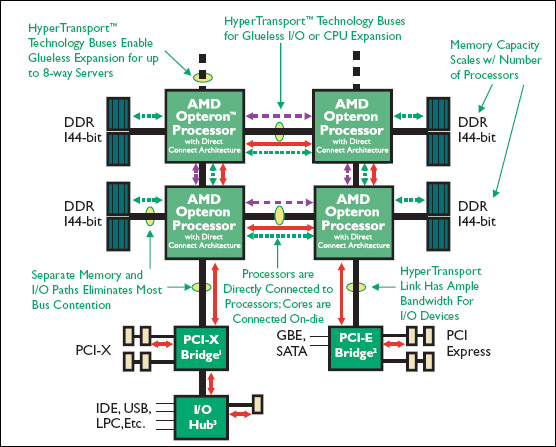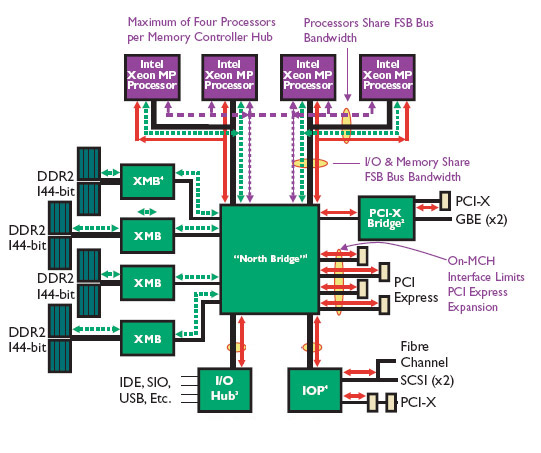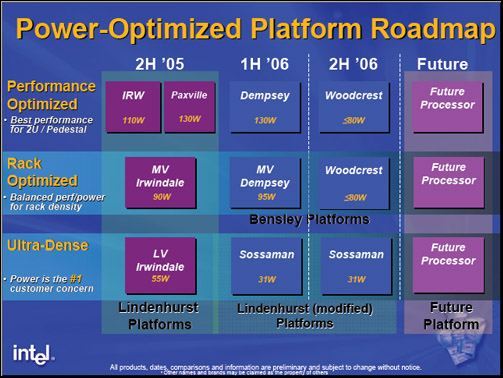Eight Core Servers: Opteron 880 (Egypt) vs. Xeon MP 3.0 GHz (Paxville)
by Jason Clark on April 24, 2006 2:00 AM EST- Posted in
- IT Computing
What do we have today?
The current AMD platform hasn't changed much at all; the only change has really been the move to 1GHz HyperTransport. The K8 architecture is fairly old news now, but is certainly still more scalable and higher performing than Intel's offerings. Intel hasn't made any significant changes, though the E8500 chipset does use a dual shared bus instead of a single bus from the older Xeon MP chipsets. The shared bus helps the bandwidth bottleneck, but with more than 4 processor cores scalability really starts to slow. The diagrams below give a high level overview of the 4P architecture that AMD and Intel currently offer.
Current 4P Architecture


AMD Server Processor Roadmap
As we mentioned, there haven't been any changes to Opteron recently, besides a speed bump and a move to 1GHz HyperTransport last year. Although the Opteron is getting up there in years, it's still a proven, scalable architecture. AMD does have some changes on the horizon for Opteron, though: DDR2 and a new socket. Will that be enough to keep them on top when Woodcrest is released? Only time will tell, but if our recent preview of socket AM2 performance is any indication, changing the server platforms to DDR2 isn't likely to increase performance much over current offerings.
We haven't seen any indications of pending changes other than the socket and memory controller. AMD is being very tightlipped about their plans for Opteron, but below is a synopsis of what we know is on the books.
Highlights
Intel Server Processor Roadmap
Intel has actually been quite forthcoming about what they are working on, for obvious reasons. They need the market to know that they are going to be competitive, and how that will be accomplished. The first two quarters of 2006 will introduce the Bensley platform, which brings the Dempsey Dual Core Xeons.
The last two quarters of the year are where things get interesting. Woodcrest is to debut in the second half of this year. Woodcrest is supposed to drop power consumption from 130W (Dempsey) to <80W, which should make a huge impact on the power consumption numbers we measured earlier this year for Dempsey. Note that Woodcrest processors will also run on the Bensley platform.

The current AMD platform hasn't changed much at all; the only change has really been the move to 1GHz HyperTransport. The K8 architecture is fairly old news now, but is certainly still more scalable and higher performing than Intel's offerings. Intel hasn't made any significant changes, though the E8500 chipset does use a dual shared bus instead of a single bus from the older Xeon MP chipsets. The shared bus helps the bandwidth bottleneck, but with more than 4 processor cores scalability really starts to slow. The diagrams below give a high level overview of the 4P architecture that AMD and Intel currently offer.
Current 4P Architecture


AMD Server Processor Roadmap
As we mentioned, there haven't been any changes to Opteron recently, besides a speed bump and a move to 1GHz HyperTransport last year. Although the Opteron is getting up there in years, it's still a proven, scalable architecture. AMD does have some changes on the horizon for Opteron, though: DDR2 and a new socket. Will that be enough to keep them on top when Woodcrest is released? Only time will tell, but if our recent preview of socket AM2 performance is any indication, changing the server platforms to DDR2 isn't likely to increase performance much over current offerings.
We haven't seen any indications of pending changes other than the socket and memory controller. AMD is being very tightlipped about their plans for Opteron, but below is a synopsis of what we know is on the books.
Highlights
- DDR2 (2006)
- AM2 Socket (2006
- Multi Core (2007)
- FBDIMM (2007)
- Shared L3 Cache (2007)
Intel Server Processor Roadmap
Intel has actually been quite forthcoming about what they are working on, for obvious reasons. They need the market to know that they are going to be competitive, and how that will be accomplished. The first two quarters of 2006 will introduce the Bensley platform, which brings the Dempsey Dual Core Xeons.
The last two quarters of the year are where things get interesting. Woodcrest is to debut in the second half of this year. Woodcrest is supposed to drop power consumption from 130W (Dempsey) to <80W, which should make a huge impact on the power consumption numbers we measured earlier this year for Dempsey. Note that Woodcrest processors will also run on the Bensley platform.











35 Comments
View All Comments
massimor - Friday, April 28, 2006 - link
I swear this is not to inject some IBM marketing into this valuable discussion (I have technical role myself within IBM and have very little to do with marketing) but I was wondering if you have evaluated running the same test on a system with a NON-vanilla Intel 8500 chipset. IBM develops its own X3 chipset to power the XEON MP servers in the x366 and x460 servers and that is supposed (actually known) to be much better than the Intel base kit.More info here:
http://www.realworldtech.com/page.cfm?ArticleID=RW...">http://www.realworldtech.com/page.cfm?ArticleID=RW...
ftp://ftp.software.ibm.com/eserver/benchmarks/wp_X...">ftp://ftp.software.ibm.com/eserver/benchmarks/wp_X...
It would have been interesting to see how the AMD based system would compare to an X3 based system. On other benchmark it's usually a head-to-head.
Massimo.
bjbrock - Wednesday, April 26, 2006 - link
is mostly true. One thing that has come out from an AMD consurtium is the Hypertransport v3. This will definitely affect the multi-processor server issue. From clusters to SMP.Art - Tuesday, April 25, 2006 - link
Would it be possible to provide details on memory configuration of both systems?Performance may depend significantly on the specific configuration. So, the test results without this type of detail don't make much sense.
Important details for Intel system:
1) Number of memory boards (this is equivalent to memory channels used)
2) Number of DIMMs per memory board
3) Memory mode (Max Performance, Max Compatibility, RAID, Mirroring)
4) Agjacent Cache Line Prefetch (enabled or disabled)
5) Hardware Prefetcher (enabled or disabled)
Important details for AMD system:
1) Memory speed (DDR400, DDR333, or DDR266)
2) ECC disabled or enabled
3) Chip Kill disabled or enabled
Thanks,
Artem
johnsonx - Tuesday, April 25, 2006 - link
Also, is the memory on the Opteron running node-interleaved or NUMA? Any comparitive benchmark numbers between the two modes?deathwalker - Tuesday, April 25, 2006 - link
"AMD is reported to have 81.5% of the US retail PC market with Intel sitting at 18.5%". A very interestng statistic. How much bigger would the margin be if the World wide leader in PC sales "Dell" would crack open the door for AMD? Alas though, that will not happen as long as Intel keeps Dell executives and board members pockets padded.tygrus - Tuesday, April 25, 2006 - link
You said,US Retail does not include Dell's direct sales, thus no inherant change in US retail sales figures.
It's a part of a part of a part of the total world-wide microprocessor sales.
Inte have trouble sharing FSB amongst more points. It's easier when it's on CPU but it's not for free. When they first went to dual-core they used 800MHz FSB instead of the EE 1066MHz and was first available for only single socket systems. This pattern continues as Intel introduces new products with limited FSB speed.
trivik12 - Monday, April 24, 2006 - link
Intel does not seem to care on MP side. Only Tulsa (last release in netburst?) with insane amount of cache is releasing. They will not be competitive until Tigerton releases mid-2007. I guess cancellation of whitefield is the culprit.peternelson - Monday, April 24, 2006 - link
"AMD is completely quiet about anything other than a socket and memory controller change;"
Yes we heard that new Opteron 1xx would be on AM2 and Opteron 2xx and 8xx would be on the new socket F.
We hear plenty about the AM2 launch (including being brought forward, and motherboards).
Things have gone quiet on the socket F. What is the latest news Anandtech? Because if everything is moving to DDR2 we ought to buy Opterons AFTER the migration rather than before. And what sort of motherboards are going to be launched to support it? Hoping to see some interesting offerings from the usual suspects like Tyan, Iwill etc.
It just would be nice to hear the odd Anandtech story to confirm things are still on some kind of schedule. If it were not for the upcoming migration I would have bought a cluster of Opterons already.
themelon - Monday, April 24, 2006 - link
Did the DL585 you guys used run the memory at 266MHz? The one that I have does but it is about 2 years old so they may have changed the specs on it.GrammatonJP - Monday, April 24, 2006 - link
Coming from a long time enterprise xeon user, its sad that intc can't even keep up.. its even sadder that my infrastructure is already setup and I can't get one of these AMD machines in till we hit our load on the current xeons.. :(